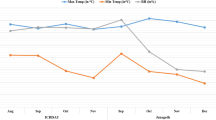Abstract
With eight isolates ofMacrophomina phaseoli, pathogenicity test was conducted on twenty varieties of jute belonging to two species,Corchorus capsularis andC. olitorius. Against six isolates the varieties screened showed different degrees of disease reactions while against the remaining two, all the varieties gave similar resistant reaction. As differential varieties, a minimum of four recognised the seven physiological races ofMacrophomina phaseoli. From the cultural characteristics, however, all the eight isolates differed from each other and were fitted in a dichotomous key as eight cultural races.
Zusammenfassung
Mit acht Stämmen vonMacrophomina phaseoli sind Pathogenitätstest an zwanzig Varietäten von Jute durchgeführt worden, die zwei Arten:Corchorus capsularis undC. olitorius angehören. Gegen sechs Stämme zeigten die untersuchten Varietäten einen verschiedenen Grad der krankhaften Reaktionen, während gegen die restlichen zwei Stämme alle Varietäten gleichartige Widerstandsfähigkeit aufwiesen. Mindestens vier von den sieben physiologischen Rassen vonM. phaseoli sind erkannt worden. Betreffs der Kulturcharakteristik wichen alle acht Stämme von einander ab und sind als echte Kulturrassen beschrieben.
Similar content being viewed by others
References
Varadarajan, B. S. &Patel, J. S. (1943) Stem-rot disease of jute.Indian J. Agri. Sci. 13:148–156.
Ishaque, M. &Badruddoza, K. M. (1958) Control of stem rot of jute by seed treatment and fungicidal sprays.Pak. J. Biol. Agri. Sci. 1:130–136.
Fazli, S. F. I. &Ahmed, Q. A. (1960) Fungus organism associated with jute seeds and their effect on germinating seeds and seedlings.Agric. Pak. 11:293–406.
Hussain M. &Ahmed, Q. A. (1960) Studies on the sporulation ofMacrophomina phaseoli (Maubl.)Ashby., causing stem-rot disease of jute with reference to the possible causes of outbreak of the disease in nature.Pak. J. Sci. Indian Res. 3:219–225.
Ahmed, Q. A. (1968) Diseases of jute in East Pakistan.Jute & Jute Fabrics, Pak. 7:147–151.
Fakir, G. A. &Ahmed, Q. A. (1965) Inheritance of resistance in jute to anthracnose (Colletotrichum corchori)Phytopath. 55:749–751.
Ahmed Nilufar &Ahmed, Q. A. (1965) Possibility of using a bacterial antagonist against fungal diseases ofPiper betle L. &Corchorus spp.Mycopath. et Mycol. appl. 27:273–279.
Mahbob-e-Illah, S. &Ahmed, Q. A. (1967) Field test of laboratory results in selecting seed dressing fungicides against seedborne diseases of jute (Corchorus capsularis L).Pak. J. Sci. Res. 19:163–170.
Kabir, M. Q., Biswas, A. C. &Ahmed, Q. A. (1968) Differential response of a few improved and local varieties as well as a hybrid line of jute to stem rot (Macrophomina phaseoli) and anthracnose (Colletotrichum corchori)Pak. J. Sci. Res. 20:34–37.
Mundkur B. B. (1949) Fungi and Plant diseases. Macmillan & Co. Ltd., London. P. 196.
Author information
Authors and Affiliations
Rights and permissions
About this article
Cite this article
Ahmed, N., Ahmed, Q.A. Physiologic specialisation in Macrophomina phaseoli (Maubl.) Ashby., causing stem rot of jute, corchorus species. Mycopathologia et Mycologia Applicata 39, 129–138 (1969). https://doi.org/10.1007/BF02053486
Issue Date:
DOI: https://doi.org/10.1007/BF02053486




